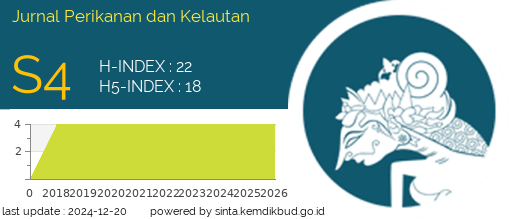Effectiveness of Setting Temperature on Moonfish Surimi Gel (Megalops cyprinoides)
DOI:
https://doi.org/10.31258/Keywords:
Moonfish, Suwari, Kamaboko, Surimi Gel StrengthAbstract
Good characteristics of surimi can be seen from its ability to form a gel, one of which is the temperature setting. This study aims to determine the effectiveness of the setting temperature on the surimi gel of moonfish (Megalops cyprinoides). The study used a completely randomized design with treatments of five temperature setting with three replications. Parameters observed were gel strength, folding test, whiteness and expressible moisture content. The results showed that setting temperature had a significant effect on gel strength, folding test, whiteness degree and expressible moisture content (p<0.05) at 95% confidence level. The setting temperature treatment of 40oC and without setting had the highest gel strength compared to other treatments with the max load values of 59.79 kg/cm2 and 60.63±1.44 kg/cm2, respectively, with a 5-fold test quality value, namely does not crack after being folded into quarters. The best setting temperature for the gel forming ability of fish surimi for moonfish is 40oC and without setting temperature.
Downloads
References
Arfat, Y.A. and S. Benjakul. 2012. Gelling characteristics of surimi from yellow stripe trevally (Selaroides leptolepis). Aquatic Research,4. 10.1186/2008-6970-4-5
Benjakul, S. and W. Visessanguan. 2009. Transglutaminase-mediated setting in bigeye snapper surimi. Food Research International, 36, 253-266.
Cahyani. TR., Bija. S., Sugi. TNL. 2020. Karakteristik Ikan Bulan-bulan (Megalops cyprinoides) dan potensinya sebagai tepung ikan. Prodi Teknologi Hasil Perikanan. Universitas Borneo. Tarakan.
Chaijan, M., S. Benjakul, W. Visessanguan, C. Faustman. 2004. Characteristics and gel properties of muscles from sardine (Sardinella gibbosa) and mackerel (Rastrelliger kanagurta) caught in Thailand. Food Research International, 37, 1021-1030.
Dewi. K. I., WIjayanti. I., Kurniasih. A. R. 2019. Pengaruh Nanokalsium Terhadap Kekuatan Gel Kamaboko Ikan Mujair (Oreochromis mossambicus). Departemen Teknologi Hasil Perikanan, FPIK, Universitas Diponegoro, Semarang. 91-101.
Jannah., C. 2010. Perubahan Karakteristik Surimi Komposisi Ikan Lelel Dumbo (Clarias gariepinus) dengan Ikan Nila Hitam (Oreochromis niloticus) Selama Penyimpanan Dingin. Skripsi. Departemen Teknologi Hasil Perikanan. IPB. Bogor.
Lanier, T.C., J. Yongsawatdigul and P. Carvajal-Rondanelli. 2014. Surimi Gelation Chemistry. In: Surimi and Surimi Seafood, Park, J.W. (Ed.)., 3rd Edn., Taylor and Francis Group, Boca Raton, Fla., pp: 130-131
Niwa, E., 1992. Chemistry of Surimi Gelation. In: Surimi Technology, Lanier, T.C. and C.M. Lee (Eds.)., Marcell Dekker, New York
Panpipat, W., M. Chaijan and S. Benjakul. 2010. Gel properties of croaker mackerel surimi blend. Food Chemistry, 122: 1122-1128.
Rasyid, N. P., Hartulistiyoso, E., dan Fardiaz, D., 2017. Aplikasi Microwave untuk Disinfestasi Tribolium castaneum (Herbst.) serta Pengaruhnya terhadap Warna dan Karakteristik Amilografi Terigu. Jurnal Agritech, 37(2), 183–191.
Santoso, J., Pradianti, O.S., Poernomo, D. 2008. Perubahan sifat fisiko-kimia surimi ikan kerot-kerot (Pomadasy hasta) selama penyimpanan beku. Jurnal Ilmu dan Teknologi Pangan. 6(1) : 75-92.
Saputra. E. 2018. Pengaruh Waktu Pencucian dan Penyimpanan Bahan Baku terhadap Ikan Nila (Oreochromis sp) Surimi dan Kamaboko. Journal of Marine and Coastal Science, 7(3).
Sari, V.R dan J. Kusnadi. (2015). Pembuatan Petis Instan (Kajian Jenis dan Proporsi Bahan Pengisi. Jurnal Pangan dan Agroindustri, 3(2),381-389.
Suzuki, T. 1981. Fish and Krill Protein. Processing Technology. London: Applied Science Publishing Ltd.
Tanikawa, E. 1985. Marine Product in Japan. Tokyo: Koseisha Koseikaku. Co. Ltd.
Wibowo, A.T., Darmanto, Y. S, Amalia, U. 2015. Karakteristik Kekian Berbahan Baku Surimi Ikan Kurisi (Nemipterus nematophorus) dengan Penambahan Daging Ikan yang Berbeda. JPBHP., 4(2): 17-24.
Zuraida, I., Raharjo, S., Hastuti, P., Indrati, R. 2017. Catfish (Clarias gariepinus) : A potential alternative raw material for Surimi Production. Pak. J. Nutr., 16 (12): 928-934.
Zuraida, I., Raharjo, S., Hastuti, P., Indrati, R. 2018. Effect of setting condition on the gel properties of surimi from catfish (Clarias gariepinus). J. Biol. Sci., 18: 223-230







